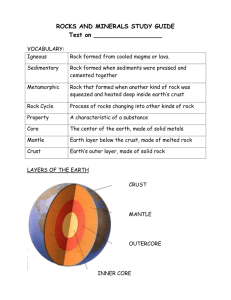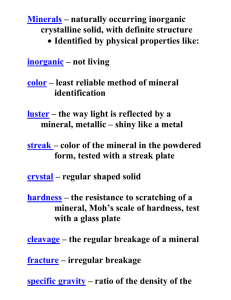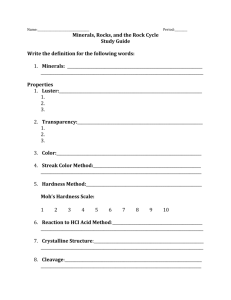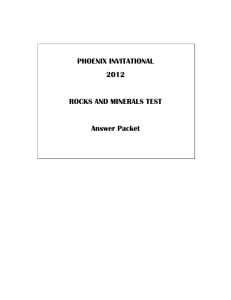EESC2200 lab - Examining Minerals, Igneous and Metamorphic
advertisement
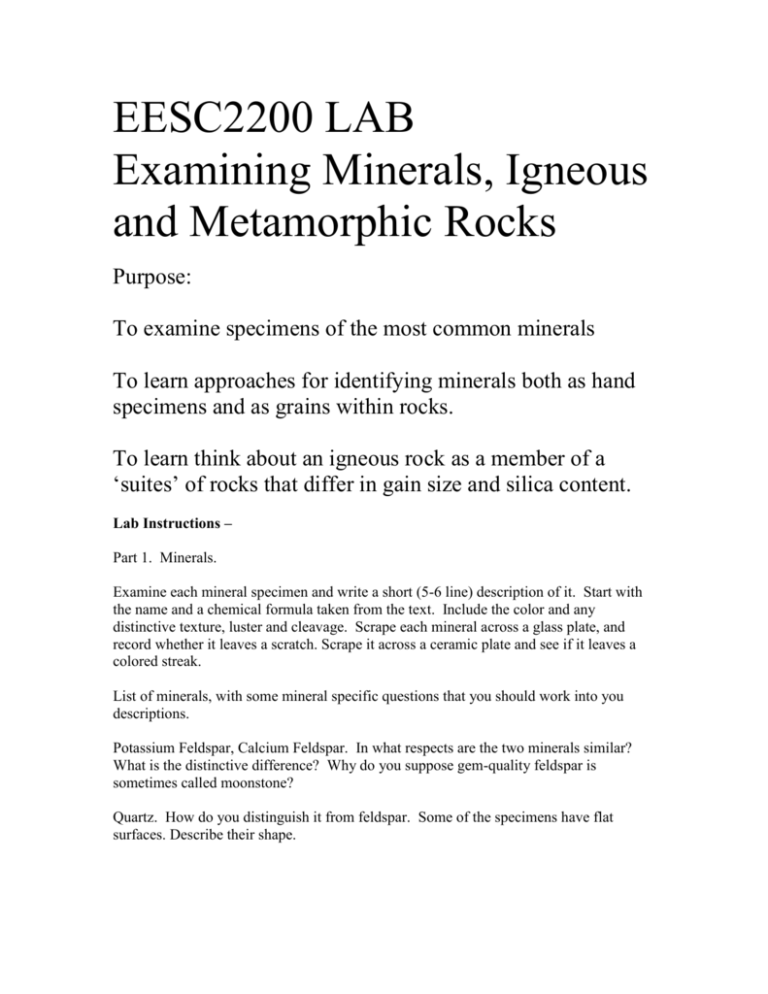
EESC2200 LAB Examining Minerals, Igneous and Metamorphic Rocks Purpose: To examine specimens of the most common minerals To learn approaches for identifying minerals both as hand specimens and as grains within rocks. To learn think about an igneous rock as a member of a ‘suites’ of rocks that differ in gain size and silica content. Lab Instructions – Part 1. Minerals. Examine each mineral specimen and write a short (5-6 line) description of it. Start with the name and a chemical formula taken from the text. Include the color and any distinctive texture, luster and cleavage. Scrape each mineral across a glass plate, and record whether it leaves a scratch. Scrape it across a ceramic plate and see if it leaves a colored streak. List of minerals, with some mineral specific questions that you should work into you descriptions. Potassium Feldspar, Calcium Feldspar. In what respects are the two minerals similar? What is the distinctive difference? Why do you suppose gem-quality feldspar is sometimes called moonstone? Quartz. How do you distinguish it from feldspar. Some of the specimens have flat surfaces. Describe their shape. Calcite: DON’T SCRATCH THE CLEAR SPECIMEN, PLEASE. PERFORM TESTS ON THE TRANSLUCENT ONE! Place the clear specimen over some printed paper. Describe the optical properties. Pyroxene, Amphibole. In what respects are the two minerals similar? What is the distinctive difference? Iron-Magnesium Mica and Calcium-Magnesium Mica. In what respects are the two minerals similar? What is the distinctive difference? Magnetite: Is it the only mineral in the collection to which the magnet is attracted? Garnet. Note that one specimen is a simple chunk of garnet, the other has small grains of mica imbedded in a second, different substance. Describe any distinctive features of the garnet grains. What mineral do you suppose the garnet grains are imbedded withing? Graphite – Why does it feel greasy? Why is the specimen wide and flat? Part 2. Igneous Rocks. Examine each igneous rock specimen and write a short (5-6 line) description of it. Start with the name and mineral constituents taken from the text. Describe the overall appearance of each rock. Then describe the rock in terms of texture (including grain size) and color. Which minerals can you identify (and to what level of certainty) in each specimen. Which rock do you suppose is sometime called volcanic glass? Arrange the rocks on the table in a grid ordered by grain-size and silica content (ie. % SiO2), drawing silica content information from the text or some other reference. Draw a sketch of this arrangement, with each specimen labeled. Part 3. Metamorphic Rocks. Examine each igneous rock specimen and write a short (5-6 line) description of it. Start with the name and mineral constituents taken from the text. Describe the overall appearance of each rock. Then describe the rock in terms of texture (including grain size), color and metamorphic fabric (e.g. platy, lineated, banded). Which minerals can you identify (and to what level of certainty) in each specimen. Each metamorphic rock could possibly have been derived by metamorphism (heating and recrystalization) of an igneous rock. Which do you suppose from which? By the way, one specimen of gneiss has a large piece of granite within it. Sketch this specimen and suggest a way that it formed. Lab report length – A half page setting out the lab purpose and methods, about 5 pages of one-paragraph rock descriptions, two sketches and a half page setting out conclusions. Include in your conclusions your own impression on how difficult you found rock and mineral identification to be.


